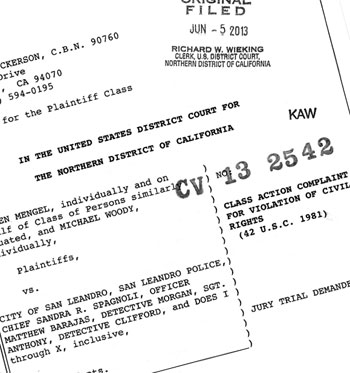 Is High School Teacher SLPD’s latest victim?
Is High School Teacher SLPD’s latest victim?
Earlier this week, the San Leandro Police Department issued a press release announcing the filing of charges for “possession of child pornography” against Rick Styner, a teacher at San Leandro High School. In one day, the reputation of a man that, by all accounts, had been honorable and respectful of his students, has been destroyed, possibly beyond repair. I don’t think any of us can imagine the social opprobrium the Styner family is experiencing right now. And yet, a careful reading of the facts as reported in the news stories do not show any actual criminal conduct by Styner. Regardless of what happens to the charges, whether they are dismissed or whether Styner is tried and found innocent, his life and career has been ruined by Chief Sandra Spagnoli and the San Leandro Police Department. And he is not the only one.
False Arrests at Marina Park
Last year, the SLPD issued another press release, featuring the pictures of two older men and accusing them of loitering around the bathrooms at Marina Park to solicit men for sex. The community reacted immediately, calling these men every name in the book and instantly assuming they were guilty. Even I, while arguing that their conduct was not a crime unless they actually intended for someone else to unwittingly witness a sex act, assumed that the basic facts of the press release were true: the men were hanging out around the bathroom hoping to pick up other men for sex. I was wrong in making that assumption. Simply put, the SLPD’s press release was a lie.
The lie was most egregious in the case of Michael Woody. Woody had stopped at the parking lot near the Marina Park bathrooms with the intention of using the facilities for their intended purpose. An undercover SLPD officer was loitering around and tried to engage Woody in conversation. When the officer followed Woody into the bathroom, Woody became understandably uncomfortable and decided to leave. The officer followed him to his car and arrested him as he was turning on the engine. Woody had never indicated any interest in engaging with the police officer on any activities. No charges were filed against him.
Steven Mengel, on the other hand, did show interest when a twenty-something plain-clothes officer Matthew Barajas approached him as he was sitting inside his car, parked in a public street, and propositioned him. They made a date to meet the next day at noon near the bathrooms. When Mengel arrived, Barajas showed up with a “friend”, now identified as Sargent Brian Anthony. They agreed that Anthony would serve as a “look out”, making sure nobody came, while Mengel gave Barajas a hand job in the bathroom stall. Before he had the opportunity to do so, he was arrested.
As I mentioned after the men’s arrest, California law only criminalizes sexual conduct in public, when it’s done under the reasonable belief that it could be witnessed by others who would be offended at the sight. Clearly, that was not the case in this case as officer Anthony’s “job” was precisely to make sure that nobody would witness the act. Disregarding the law, the SLPD officers not only arrested Mengel but they issued a press release falsely accusing him of loitering with the intent of engaging in illegal acts. He was actually charged with this offense – which suggests to me that we should give little credence to any charges the Alameda County District Attorney levies against anyone -, but the charges were dismissed by the court.
Unfortunately, it will ultimately be San Leandro residents that have to pay for the SLPD’s misconduct – the city has been hit by a class-action lawsuit filed on behalf of Mengel, Woody, and all other men who have been subjected to similar actions by the SLPD. While the lawsuit does not specify an amount for damages, similar lawsuits have resulted in settlements in the six and seven figures. So much for Mayor Cassidy’s argument that the City should give Chief Spagnoli a raise because she would save the city money on lawsuits.
The Styner Case
(Update: the actual court documents in this case show that the charges are bogus).
What happened in the Marina Park should warn us against jumping to conclusions on the Styner case as well. Indeed, a close examination of the facts on this case show that it’s not only weak but suspicious.
Rick Styner is a Computer Science teacher at San Leandro High School. On April 16, he was teaching his class how to transfer files between devices, when he accidentally clicked on a file in his dropbox folder, opening a nude photograph of himself. The police have not described this photograph, but according to what a student of Styner’s wrote on Facebook, it actually focused on the tattoos that Styner sports on his thigh – he gets one after he completes a marathon -, and only incidentally showed his genitalia. *Update*. After writing this part I looked through Styner’s facebook page and found a picture of the tattoo. It’s actually on his right hip, and while this particular picture is cropped, it’s reasonable to believe that the original might have shown part of his genitalia and might have been the one the students were exposed to. It’s clear that the purpose of this picture was to show off the tattoo. Styner got it in August 2012; the little balls signify the marathon’s he’s completed, the number signifies the distance of the marathon (26.2 miles) and the phrase means “will run” in a Tolkien language.
Immediately after this incident, Styner notified the school authorities and surrendered his school-issued laptop computer. An unidentified school district employee proceeded to look through the computer where s/he allegedly found material that s/he considered to be disturbing. The district notified the police, without first notifying the School Board.
The material in question seems to mostly consist of written erotica and is fully protected by the first amendment. According to news reports, one of these stories concerned incest between two teenage siblings (update, this story appears to be “Flowers in the Attic” by V.C. Andrews) , and it included a naked picture of a woman who looked like she might be underage. The Police has not said whether they have identified the woman or confirmed that she is, indeed, underage. The picture has not otherwise been described, so we don’t know if it is actually pornographic (not all naked pictures of minors are; “Pretty Baby” can still be shown in theaters in California even though it shows a naked, pre-pubescent Brooke Shields. Did you click on that last links? You are now in danger of having the SLPD arrest you for possession of child pornography.).
The police have also not stated whether the story had actually been authored by Rick Styner, or whether he had downloaded it. If the latter, the police must show that Steiner actually knew the story contained a pornographic picture of an underage girl. After all, it’s extremely common for people to download large story collections, and not necessarily read or examine every single one. It’s also very easy to unwittingly receive material – specially via a dropbox account – that one did not seek or is aware of. And it’s not always easy to be able to tell the age of a model by her picture alone, much less determine whether the picture is actually pornographic. Is this picture of Brooke Shields child pornography? You tell me – but if you look, beware that the picture will be downloaded to your computer and you’ll be potentially just as guilty of possessing child pornography as Rick Styner. Which is likely, not at all. “Possession of child pornography” is an intent crime, so unwittingly downloading pictures that you don’t know to be pornographic is not a crime.
My personal feeling is that if Styner was, indeed, interested in child pornography, there would have been hundreds of child porn pictures in his computer, not just one of someone who looks like she may be underage and who is not apparently engaged in actual sexual conduct.
The second charge against Rick Styner is even more bizarre. He is accused of going into the home of a friend, who had given him the key, and taking pictures of her underwear and running clothing. He is also accused of putting the picture of the woman’s head on pictures of naked bodies. Apparently, he also took something from the woman’s home, which the police would not identify.
Now, I understand that the Police is trying to suggest that he took pictures of the clothing because of some weird sexual kink – but I find it interesting that the pictures also included the woman’s running gear. Could it be that Styner – a marathoner – was actually more interested in the brand and style of the clothing? I don’t know if he actually removed an item of clothing from his friend’s house – the police has shown that it’s not above lying in print and they might have made this up so that they can charge him with burglary -, but could it not have been for a similarly innocuous reason, such as showing it to his wife to see if she’d like one like it?
As for the photographs – putting someone’s head on someone else’s body, however disturbing, is definitely not a crime, which begs the question of why the police would make such a big deal about it.
I have not personally met Rick Styner – though he is a facebook friend of this blog -, and I have no insight into who he is. I do know, however, that when I googled him, what I first found about him (other than stories on these charges) were stories about how when SLHS teachers were protesting having to put anti-LGBT-bullying posters on their classrooms, Styner said he would put two. Given the clear anti-LGBT bias that the SLPD has shown, and which still lingers at the school district, it makes me wonder if there could be a connection there.
In any case, so far it does not appear that Rick Styner has committed any crime, at least no more than what I did when I googled images of “Brook Shields Pretty Baby” and automatically downloaded several of her underage and naked into my computer. Then again, I would not be surprised if the SLPD was knocking at my home next.
 City Moves to Ban E-Cigarettes Despite Lack of Complaints About Their Use
City Moves to Ban E-Cigarettes Despite Lack of Complaints About Their Use
 At the next closed-session meeting of the City Council, the Council will be briefed on a number of lawsuits against the City making their way through the court system. While they are not the totality of the lawsuits affecting the City, it’s useful for citizens to know what their City’s legal team is spending taxpayer money fighting.
At the next closed-session meeting of the City Council, the Council will be briefed on a number of lawsuits against the City making their way through the court system. While they are not the totality of the lawsuits affecting the City, it’s useful for citizens to know what their City’s legal team is spending taxpayer money fighting. Unfortunately, there have been several incidents like this one, where a witness or victim calls the Police, and they end up becoming the victims of police abuse. I reported on a
Unfortunately, there have been several incidents like this one, where a witness or victim calls the Police, and they end up becoming the victims of police abuse. I reported on a 
 HOA Misses Deadline for CEQA Lawsuit on Halus Wind Turbine
HOA Misses Deadline for CEQA Lawsuit on Halus Wind Turbine